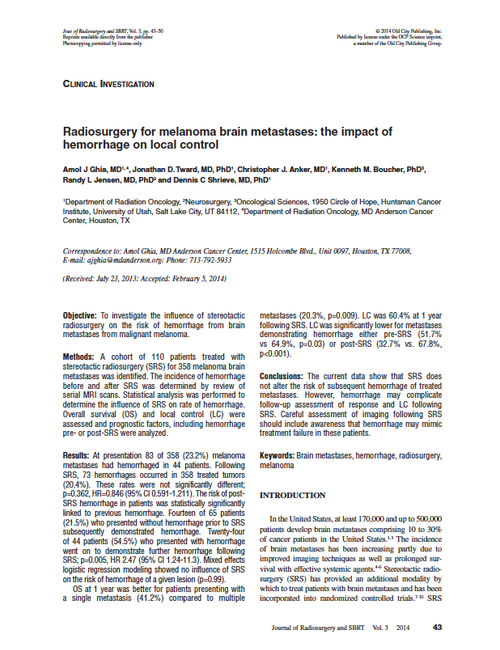- Home
- Journal Contents Downloads
- JRSBRT Downloads
- JRSBRT 3.1, p. 43-50
Product Description
Radiosurgery for melanoma brain metastases: the impact of hemorrhage on local control
Amol J. Ghia, Jonathan D. Tward, Christopher Anker, Kenneth M. Boucher, Randy L. Jensen and Dennis C. Shrieve
Objective: To investigate the influence of stereotactic radiosurgery on the risk of hemorrhage from brain metastases from malignant melanoma.
Methods: A cohort of 110 patients treated with stereotactic radiosurgery (SRS) for 358 melanoma brain metastases was identified. The incidence of hemorrhage before and after SRS was determined by review of serial MRI scans. Statistical analysis was performed to determine the influence of SRS on rate of hemorrhage. Overall survival (OS) and local control (LC) were assessed and prognostic factors, including hemorrhage pre- or post-SRS were analyzed.
Results: At presentation 83 of 358 (23.2%) melanoma metastases had hemorrhaged in 44 patients. Following SRS, 73 hemorrhages occurred in 358 treated tumors (20.4%). These rates were not significantly different; p=0.362, HR=0.846 (95% CI 0.591-1.211). The risk of post- SRS hemorrhage in patients was statistically significantly linked to previous hemorrhage. Fourteen of 65 patients (21.5%) who presented without hemorrhage prior to SRS subsequently demonstrated hemorrhage. Twenty-four of 44 patients (54.5%) who presented with hemorrhage went on to demonstrate further hemorrhage following SRS; p=0.005, HR 2.47 (95% CI 1.24-11.3). Mixed effects logistic regression modeling showed no influence of SRS on the risk of hemorrhage of a given lesion (p=0.99).
OS at 1 year was better for patients presenting with a single metastasis (41.2%) compared to multiple metastases (20.3%, p=0.009). LC was 60.4% at 1 year following SRS. LC was significantly lower for metastases demonstrating hemorrhage either pre-SRS (51.7% vs 64.9%, p=0.03) or post-SRS (32.7% vs. 67.8%, p<0.001).
Conclusions: The current data show that SRS does not alter the risk of subsequent hemorrhage of treated metastases. However, hemorrhage may complicate follow-up assessment of response and LC following SRS. Careful assessment of imaging following SRS should include awareness that hemorrhage may mimic treatment failure in these patients.
Keywords: lung cancer, chemoradiation, PET scan, response to treatment
After payment has been processed for your order of a digital copy (PDF) of this article, you will see a download link on your completed order page and also receive an email containing a download link. The links, which will enable you to download one copy of the article, will expire after 24 hours.
 Loading... Please wait...
Loading... Please wait...



